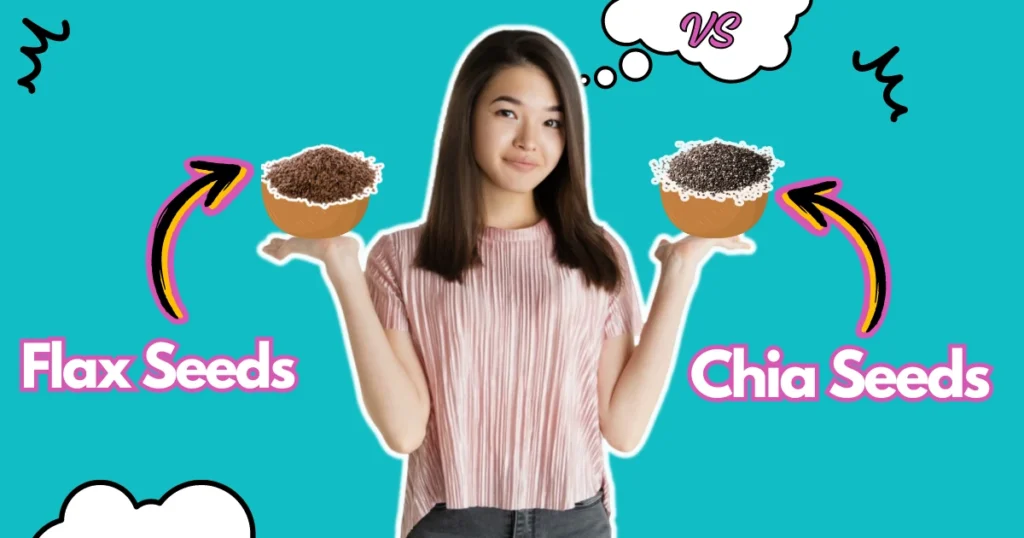
Chia seeds and flax seed have gained popularity in recent years, not solely due to their aesthetic appeal. Flaxseed, characterized by its tan and pear-shaped form, contrasts with chia seeds, which are small and exhibit a marbled appearance with black, brown, and white hues. Both varieties of seeds offer an abundance of nutrients, health benefits, and culinary versatility.
Difference Between Flax Seeds vs Chia Seeds?
- Compared to chia seeds, flax seeds have a significantly higher concentration of alpha-linolenic acid (ALA), a type of omega-3 fatty acid. ALA reduces inflammation and is good for the heart.
- Chia seeds have a higher dietary fiber content per serving than flax seeds. Fiber supports gut health in general, facilitates digestion, and encourages satiety.
- Flax seeds are rich in lignans, which are strong antioxidants associated with a number of health advantages, such as a lower chance of developing chronic illnesses like cancer. Chia seeds have antioxidant qualities as well, though not as much as flax seeds.
- When soaked, chia seeds have the unusual capacity to absorb water and take on the consistency of gel, which can be used to thicken recipes or replace eggs. This gel-forming property is absent from flax seeds.
- Chia seeds are richer in certain minerals like calcium, magnesium, and phosphorus compared to flax seeds. These minerals are essential for bone health, muscle function, and overall well-being.
- The flavor of flax seeds is slightly nuttier than that of chia seeds, which are rather bland. All kinds of seeds can, however, be easily incorporated into a wide range of recipes.
Similarities of Chia and Flax Seeds
There are various similarities between the nutritional profiles and health benefits of chia and flaxseeds.
1. Omega-3 Fatty Acids: Chia and flaxseeds are good sources of alpha-linolenic acid (ALA), one of the omega-3 fatty acids. These vital fatty acids improve brain function, lower inflammation, and support heart health.
2. Dietary Fiber: Both seeds are rich in dietary fiber, which aids in digestion, controls bowel motions, and increases feelings of fullness. You can support a healthy digestive system and help manage your weight by including chia or flaxseeds in your diet.
3. Antioxidants: The antioxidants found in chia and flaxseeds aid in the fight against oxidative stress and shield cells from harm. Antioxidants are essential for maintaining general health and longevity, as well as lowering the risk of chronic diseases.
4. Plant-Based Protein: Flaxseeds and chia seeds are excellent supplements to vegetarian and vegan diets because they are sources of plant-based protein. Protein is necessary for immune system function, hormone synthesis, and muscle growth and repair.
5. Versatility: Flaxseeds and chia seeds are adaptable ingredients that work well in a wide range of recipes. They can be combined with salads and dressings, added to smoothies, used as a binding agent in baking recipes, or sprinkled over yogurt or oatmeal.
Nutrition Comparison
A wide range of nutrients can be found in both chia and flax seeds.
| Nutrients | Flax seeds | Chia seeds |
|---|---|---|
| Calories | 150 | 138 |
| Carbs | 8 grams | 12 grams |
| Fiber | 8 grams | 10 grams |
| Protein | 5 grams | 5 grams |
| Fat | 12 grams | 9 grams |
| Thiamine | 38% of the DV | 15% of the DV |
| Magnesium | 26% of the DV | 23% of the DV |
| Phosphorus | 5% of the DV | 5% of the DV |
| Copper | 38% of the DV | 29% of the DV |
| Selenium | 13% of the DV | 28% of the DV |
| Iron | 9% of the DV | 12% of the DV |
| Zinc | 11% of the DV | 12% of the DV |
| Calcium | 6% of the DV | 14% of the DV |
| Potassium | 5% of the DV | 2% of the DV |
Omega-3 fats and protein are both present in good amounts in both seeds. An ounce of chia seeds has 4,915 mg of omega-3s, compared to 6,388 mg in an ounce of flax (1, 2).
Additionally, flax seeds contain much more potassium and copper.
Chia seeds are higher in fiber and slightly lower in calories. Along with slightly higher levels of iron and phosphorus, they also contain 2.5 times more calcium, a mineral that strengthens bones.
Chia Seeds and Flaxseeds? Which One is Healthier?
Chia seeds and flaxseeds are both highly regarded as superfoods, boasting remarkable nutritional qualities. Although flaxseeds contain lignans, which chia seeds lack, both seeds provide similar and significant health advantages. Including either of these seeds in your diet can promote numerous beneficial effects on your overall well-being.
Conversely, flax and chia have different functions when it comes to meals and recipes. Chia seeds, known for their high nutritional content, can be used to thicken puddings, smoothies, and soups, although they have a subtle taste. In contrast, flaxseeds provide a nutty flavor to savory dishes or can be utilized as a replacement for eggs in baked goods.
How to use flax and chia seeds
- Chia and flax seeds are both highly adaptable and simple to include in your diet. They both have fairly neutral tastes, so you can use them in almost anything.
- Sprinkle them over yogurts or add them to baked goods, smoothies, or oatmeal. Both can be substituted for eggs in many recipes or used to thicken sauces.
- In reference to the quantity consumed, the majority of the advantages mentioned above were observed with 1-2 tablespoons (10–20 grams) of seeds daily.
- While both types can be eaten whole, there are benefits to eating them ground.
- Complete flax seeds are able to pass through your digestive system undigested because their outer shells are difficult for your intestines to process. The nutrients they contain can be more readily absorbed if they are eaten ground.
- Whole chia seeds are frequently eaten. Nonetheless, research indicates that grinding the seeds may also improve absorption of the nutrients they contain.
- Whole chia seeds are frequently eaten. But research has indicated that grinding the seeds may also improve the absorption of the nutrients they contain.
- Both kinds of seeds should ideally be kept in the freezer or refrigerator due to their high fat content to keep them from going rancid. For the same reason, be sure to eat them right away.
Can Chia and Flax Seeds be Consumed Together?
Consuming chia and flax together is a great way to obtain a wide range of nutrients, including fiber, plant protein, and omega-3 fatty acids. By adding flaxseeds to chia, you can also benefit from lignans, which are not naturally found in chia seeds. However, it is important to note that both chia and flaxseeds are high-fiber superfoods, so it is advisable to introduce them slowly into your diet to avoid any possible digestive discomfort.
Frequently Asked Questions
Q1: How should chia and flax seeds be stored?
A1: Keep them in the fridge or freezer to maintain freshness.
Q2: Are there any potential allergic reactions or side effects associated with consuming chia seeds or flax seeds?
A2: Allergic reactions to chia or flax seeds are rare but possible. Some people may experience digestive issues like bloating or gas.
Q3: Can chia seeds and flax seeds be eaten raw, or do they need to be cooked or soaked?
A3: Both chia and flax seeds can be eaten raw or added to recipes without cooking. Soaking chia seeds can create a gel-like texture, while grinding flax seeds can enhance nutrient absorption.
People Also Like To Read:
- The Ultimate Guide to Overnight Oats with Oat Milk
- Marvel Milk Boost: Overnight Oats For Breastfeeding
- The Lifecycle of Chia Seeds: Do Chia Seeds Go Bad?
- 10 Benefits Of Lime Water for Health 2024
The Bottom Line
Flax seeds vs chia seeds are both excellent sources of nutrients and have health advantages. Adding flax and chia seeds to your diet can improve your overall health because of their high fiber content and omega-3 fatty acids. They are easily added to a variety of recipes due to their versatility. To prevent digestive problems, start with small amounts and increase your intake gradually. It’s true that chia and flax seeds are good additions to a balanced diet.


